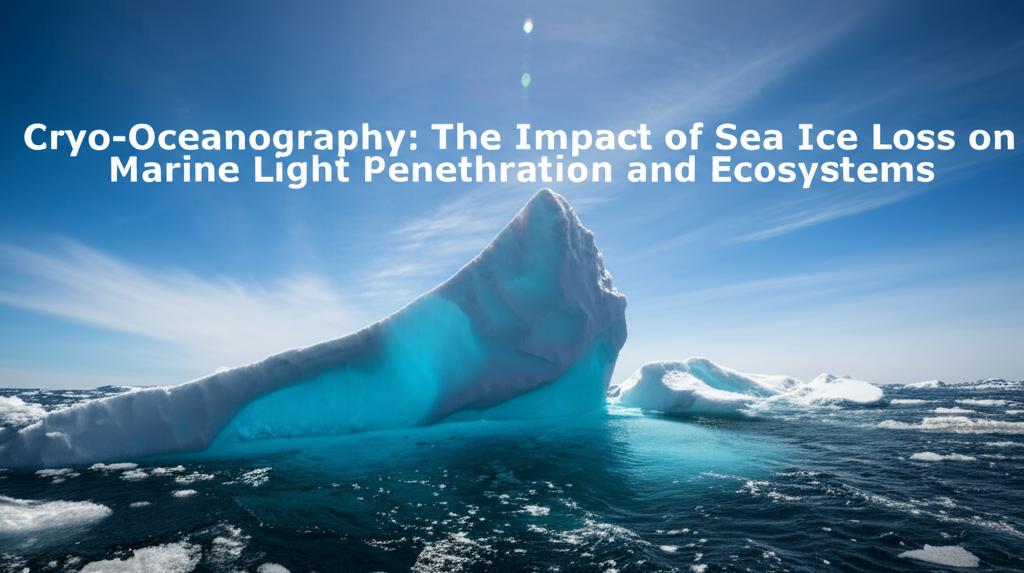The ongoing decline of sea ice in polar regions, driven by global warming, is not only increasing the total amount of light entering the ocean but also significantly altering the color spectrum of this underwater light. These changes have profound and far-reaching consequences for marine ecosystems, particularly for photosynthetic organisms like ice algae and phytoplankton, which form the base of the polar food web.
Recent research highlights a critical distinction in how sea ice and open seawater transmit light. Sea ice, while reflecting a significant portion of sunlight and allowing only a small fraction to penetrate, scatters light in such a way that a broad range of visible wavelengths can still reach the organisms below. This means that life under sea ice has adapted to a diverse, multi-colored, albeit dim, light environment.
In stark contrast, liquid seawater rapidly absorbs red and green wavelengths, allowing blue light to penetrate much deeper. This is what gives the open ocean its characteristic blue hue. A key reason for this difference lies in the behavior of water molecules. In liquid water, molecules are free to move and vibrate, leading to the formation of distinct absorption bands that selectively remove portions of the light spectrum. In the crystalline structure of ice, these molecular vibrations are suppressed, resulting in a smoother absorption spectrum that preserves a broader range of light colors.
As sea ice melts and gives way to open water, the underwater light environment fundamentally shifts. Organisms that were once bathed in a wide spectrum of colors are now exposed to a narrower, blue-dominated environment. This spectral shift is crucial for photosynthesis. Algae living under sea ice possess photosynthetic pigments optimized to utilize the broad range of light colors available. When this ice disappears, these organisms find themselves in a light environment that is a poorer match for their existing pigment compositions.
This change in light quality can alter photosynthetic performance and is predicted to lead to shifts in species composition. Algal species that are specialized in utilizing blue light may gain a significant competitive advantage over traditional ice algae. Observational data from some coastal Antarctic waters already indicate an increase in cryptophytes, which are better suited to blue light, alongside a decline in pigment-rich species adapted to the under-ice environment.
These ecological implications are not trivial. Photosynthetic algae are the foundation of Arctic and Antarctic food webs. Any changes in their productivity, abundance, or species composition can have cascading effects, rippling upwards to impact fish, seabirds, and marine mammals. Furthermore, photosynthesis in the ocean plays a vital role in the natural uptake of atmospheric carbon dioxide.
The diminishing sea ice also means that open water periods are becoming longer, allowing more light to penetrate below the surface for extended durations. While this might initially suggest an increase in overall primary production, the reality is more complex. Factors such as increased suspended particles from glacial or terrestrial runoff, and potentially increased cloudiness, can limit light penetration in coastal areas. In some regions, even with more sunlight reaching the ocean surface due to ice loss, the water transparency has decreased as phytoplankton, sediments, and dissolved substances quickly absorb the light, preventing much of it from reaching the seafloor. Therefore, any anticipated boost in primary production is not uniform across all polar regions and varies significantly depending on local conditions.
The timing of sea ice melt and freeze-up is also critical. Earlier melting and later freezing extend the ice-free period, increasing light availability during months that historically had very low light levels. This can influence the timing and intensity of phytoplankton blooms.
In addition to these direct impacts on light, the loss of sea ice affects marine ecosystems in other ways. For example, the seasonal vertical migration patterns of zooplankton, which are influenced by light availability, are being altered. This could lead to food shortages for zooplankton and, consequently, for larger species that depend on them. The reduction in sea ice also impacts species that rely on it as a habitat for breeding and rearing young, such as certain seals and walruses.
In summary, the cryo-oceanographic changes brought about by sea ice loss are multifaceted. The increased light penetration and, crucially, the shift in the spectral quality of that light, are leading to a restructuring of the base of the marine food web. These changes, combined with other effects of a warming climate, pose significant challenges to the delicate balance of polar marine ecosystems.

